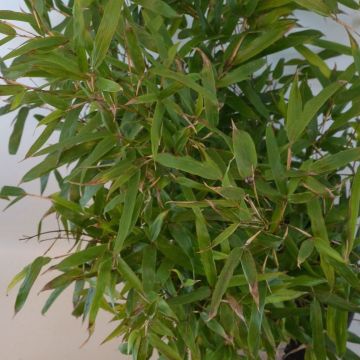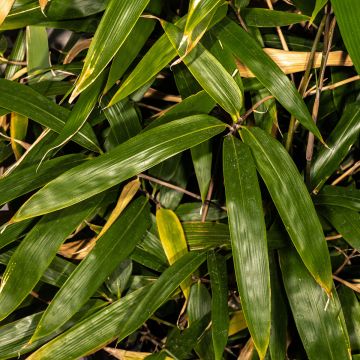

Sasa tsuboiana Pseudosasa japonica
Sasa tsuboiana Pseudosasa japonica
Sasa tsuboiana
Bamboo
Arrived damaged and very yellow, we hope it will recover... 1 star instead of 5
Amandine Q., 11/03/2020
Special offer!
Receive a €20 voucher for any order over €90 (excluding delivery costs, credit notes, and plastic-free options)!
1- Add your favorite plants to your cart.
2- Once you have reached €90, confirm your order (you can even choose the delivery date!).
3- As soon as your order is shipped, you will receive an email containing your voucher code, valid for 3 months (90 days).
Your voucher is unique and can only be used once, for any order with a minimum value of €20, excluding delivery costs.
Can be combined with other current offers, non-divisible and non-refundable.
Home or relay delivery (depending on size and destination)
Schedule delivery date,
and select date in basket
This plant carries a 24 months recovery warranty
More information
We guarantee the quality of our plants for a full growing cycle, and will replace at our expense any plant that fails to recover under normal climatic and planting conditions.
Would this plant suit my garden?
Set up your Plantfit profile →
Description
The Sasa tsuboiana, semi-evergreen dwarf bamboo, is dense and bushy with numerous branches and displays magnificent decorative foliage, with large dark green glossy leaves. Low-maintenance and perfectly hardy, it thrives in indirect sun as well as dense shade, in any moist, well-drained soil. A must-have for small zen, Japanese or contemporary gardens !
The Sasa tsuboiana is a type of dwarf bamboo that is dense and compact, with upward branches that are regular in shape. It is perfect for temperate climates and originates from Japan. Belonging to the grass family known as Poaceae, this small bamboo has pale green culms or canes slightly tinged with purple. The diameter of the culms is 5 to 8 mm (0.2 - 0.3 in), and the height can reach anywhere from 1 to 2 m (3 ft 4 in - 6 ft 7 in). It grows rapidly, forming a beautiful, rounded, and bushy clump that is both erect and spreading. The semi-evergreen foliage consists of large glossy and dark green leaves measuring 15 to 28 cm (5.9 - 11 in) in length and 3 to 6 cm (1.2 - 2.4 in) in width. The leaf margins tend to dry out with the first frosts, giving the appearance of a cream margin, which gives this small bamboo a decorative variegated character. During the winter, the bamboo becomes bare, but from early spring, new leaves appear that will reform its splendid lush foliage.
Sasa tsuboiana is a highly adaptable and easy-to-grow bamboo that is robust, hardy, and undemanding. It forms a dense, branching, and rounded mass that is perfect for zen, exotic, or contemporary gardens. However, it should not be planted in direct sunlight, dry soils, or windy areas.
This versatile bamboo can be used as a hedge by planting it at a distance of 70 to 80 cm (27.6 - 31.5 in), or as a specimen by pruning it repeatedly into a flattened ball. It tolerates shade well and can be used as ground cover under trees like caramel tree and Japanese maple in woodland settings.
In a shrub bed, Sasa tsuboiana pairs well with sacred bamboo, spindle tree, or Loropetalum. It can also be grown in a rockery, on a slope, or as a solitary clump. This dwarf bamboo is perfect for large pots or planters on a terrace or balcony. It can be combined with black bamboo and different Fargesia varieties with different stems and foliage, creating a tropical scene with an exotic appearance.
If you want to give your small garden a Japanese character, Sasa tsuboiana is the perfect bamboo for the job.
Report an error about the product description
Sasa tsuboiana Pseudosasa japonica in pictures


Plant habit
Foliage
Botanical data
Sasa
tsuboiana
Gramineae
Bamboo
East Asia
Other Bamboos
View all →Planting and care
The Sasa tsuboiana is an easy-to-grow bamboo plant that needs little attention. It can be planted in late summer, autumn, or spring. Although it does not spread too much, it's best to use a rhizome barrier to control its growth. This plant can withstand low temperatures as low as -22°C (-7.6°F). It grows well in partial or deep shade and light sun, but it doesn't like windy conditions. It adapts to most soils but prefers rich, moist and well-drained soil that's slightly acidic. It tolerates drought well when grown in the ground. If you grow it in a container, use well-draining potting soil and fertilise twice a year to avoid leaf yellowing. You can propagate the plant by cutting its rhizomes or dividing its clumps. You can prune it every spring to promote new foliage growth.
Planting period
Intended location
Care
-
, onOrder confirmed
Reply from on Promesse de fleurs
Similar products
Haven't found what you were looking for?
Hardiness is the lowest winter temperature a plant can endure without suffering serious damage or even dying. However, hardiness is affected by location (a sheltered area, such as a patio), protection (winter cover) and soil type (hardiness is improved by well-drained soil).

Photo Sharing Terms & Conditions
In order to encourage gardeners to interact and share their experiences, Promesse de fleurs offers various media enabling content to be uploaded onto its Site - in particular via the ‘Photo sharing’ module.
The User agrees to refrain from:
- Posting any content that is illegal, prejudicial, insulting, racist, inciteful to hatred, revisionist, contrary to public decency, that infringes on privacy or on the privacy rights of third parties, in particular the publicity rights of persons and goods, intellectual property rights, or the right to privacy.
- Submitting content on behalf of a third party;
- Impersonate the identity of a third party and/or publish any personal information about a third party;
In general, the User undertakes to refrain from any unethical behaviour.
All Content (in particular text, comments, files, images, photos, videos, creative works, etc.), which may be subject to property or intellectual property rights, image or other private rights, shall remain the property of the User, subject to the limited rights granted by the terms of the licence granted by Promesse de fleurs as stated below. Users are at liberty to publish or not to publish such Content on the Site, notably via the ‘Photo Sharing’ facility, and accept that this Content shall be made public and freely accessible, notably on the Internet.
Users further acknowledge, undertake to have ,and guarantee that they hold all necessary rights and permissions to publish such material on the Site, in particular with regard to the legislation in force pertaining to any privacy, property, intellectual property, image, or contractual rights, or rights of any other nature. By publishing such Content on the Site, Users acknowledge accepting full liability as publishers of the Content within the meaning of the law, and grant Promesse de fleurs, free of charge, an inclusive, worldwide licence for the said Content for the entire duration of its publication, including all reproduction, representation, up/downloading, displaying, performing, transmission, and storage rights.
Users also grant permission for their name to be linked to the Content and accept that this link may not always be made available.
By engaging in posting material, Users consent to their Content becoming automatically accessible on the Internet, in particular on other sites and/or blogs and/or web pages of the Promesse de fleurs site, including in particular social pages and the Promesse de fleurs catalogue.
Users may secure the removal of entrusted content free of charge by issuing a simple request via our contact form.
The flowering period indicated on our website applies to countries and regions located in USDA zone 8 (France, the United Kingdom, Ireland, the Netherlands, etc.)
It will vary according to where you live:
- In zones 9 to 10 (Italy, Spain, Greece, etc.), flowering will occur about 2 to 4 weeks earlier.
- In zones 6 to 7 (Germany, Poland, Slovenia, and lower mountainous regions), flowering will be delayed by 2 to 3 weeks.
- In zone 5 (Central Europe, Scandinavia), blooming will be delayed by 3 to 5 weeks.
In temperate climates, pruning of spring-flowering shrubs (forsythia, spireas, etc.) should be done just after flowering.
Pruning of summer-flowering shrubs (Indian Lilac, Perovskia, etc.) can be done in winter or spring.
In cold regions as well as with frost-sensitive plants, avoid pruning too early when severe frosts may still occur.
The planting period indicated on our website applies to countries and regions located in USDA zone 8 (France, United Kingdom, Ireland, Netherlands).
It will vary according to where you live:
- In Mediterranean zones (Marseille, Madrid, Milan, etc.), autumn and winter are the best planting periods.
- In continental zones (Strasbourg, Munich, Vienna, etc.), delay planting by 2 to 3 weeks in spring and bring it forward by 2 to 4 weeks in autumn.
- In mountainous regions (the Alps, Pyrenees, Carpathians, etc.), it is best to plant in late spring (May-June) or late summer (August-September).
The harvesting period indicated on our website applies to countries and regions in USDA zone 8 (France, England, Ireland, the Netherlands).
In colder areas (Scandinavia, Poland, Austria...) fruit and vegetable harvests are likely to be delayed by 3-4 weeks.
In warmer areas (Italy, Spain, Greece, etc.), harvesting will probably take place earlier, depending on weather conditions.
The sowing periods indicated on our website apply to countries and regions within USDA Zone 8 (France, UK, Ireland, Netherlands).
In colder areas (Scandinavia, Poland, Austria...), delay any outdoor sowing by 3-4 weeks, or sow under glass.
In warmer climes (Italy, Spain, Greece, etc.), bring outdoor sowing forward by a few weeks.


















































